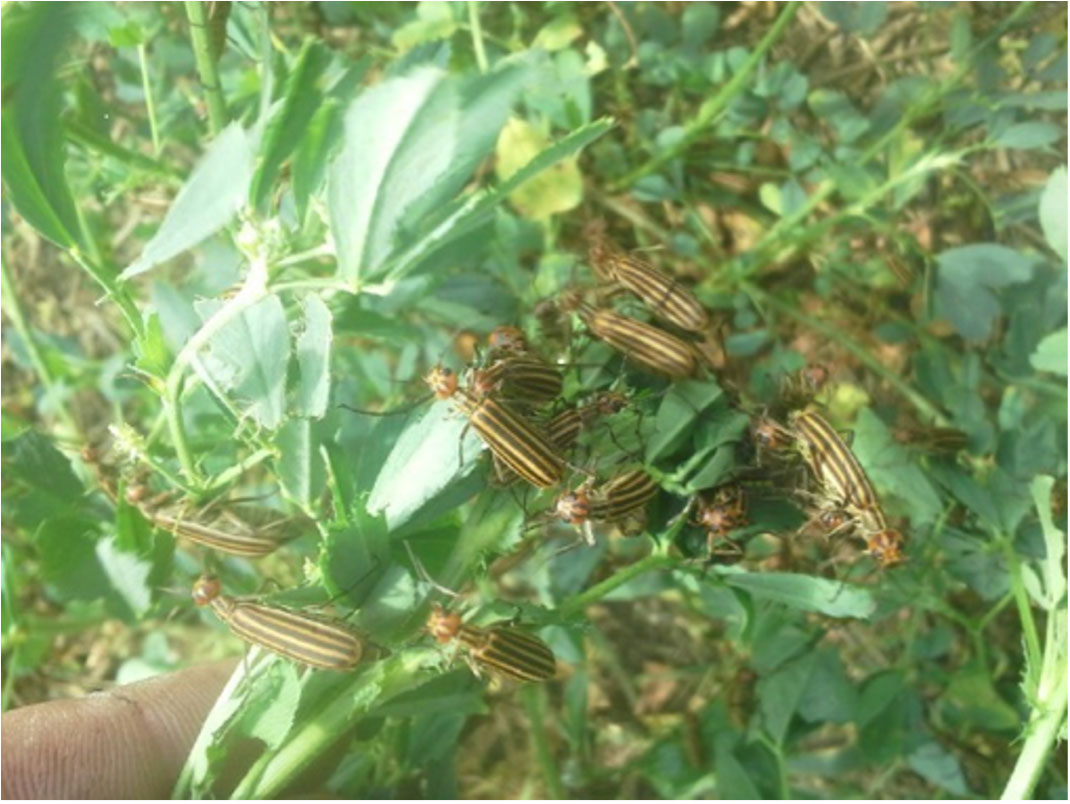Blister Beetles Activity in Alfalfa, Pasture, and Lawns
This time of year, blister beetles can become a major consideration to alfalfa hay buyers and producers. In Oklahoma, adult beetles are active from mid-May to early fall. Striped blister beetles generally concentrate in higher numbers in June and July. I have received reports of increased blister beetle activity in the past couple of weeks. While most people think of blister beetles as predominately an alfalfa hay risk, they can also be of concern for pasture (hay meadows) and homeowners.
Alfalfa: For alfalfa producers, several species commonly occur in Oklahoma. An estimated 75% of the total number of blister beetles occurring in Oklahoma alfalfa are striped blister beetles Epicauta occidentalis (Fig. 1). Another common blister beetle found in Oklahoma is the black blister beetle Epicauta pensylvanica (Fig. 3).
Figure 1. Adult Striped Blister Beetle. Epicauta occidentalis Photo credit, Bug Guide.
While all species contain Cantharidin, the striped blister beetle contains the most concentration of the toxin (5 mg/beetle) compared to other blister beetle species (0.5 mg/beetle). Cantharidin provides beetles a defense mechanism but may also affect livestock health when beetles are inadvertently incorporated into baled alfalfa during harvest. When livestock, particularly horses, are fed forage containing bodies or fragments of these insects, illness or death can result.
Because of their congregating (swarming) nature, remains of beetles killed during the alfalfa harvesting process can be concentrated in a few hay bales or small portions of bales (Fig. 2).
Figure 2. Blister Beetle Swarm.
Photo Credit, Oklahoma State University Extension.
Cantharidin is a stable compound that retains its toxicity to livestock even when dried remains of the beetles are fed along with the forage. The number of blister beetles needed to cause harm, especially horses, can vary greatly depending on breed, size, and nutritional state. The lethal dose is estimated to be between 0.5 and 1.0 mg Cantharidin per kilogram (2.2 lbs) of body weight (UK Ext., 2023).
In alfalfa, the source of many blister beetles is from their attraction and feeding on foliage and blooms. Treating border areas with low residual pyrethroids can help control migration into alfalfa hay fields. However, blister beetles are also attracted to broadleaf weeds and other plants blooming in or near alfalfa fields, in grass pastures, or homeowner lawn and gardens.
Figure 3. Black Blister Beetle. Epicauta pensylvanica.
Photo, Maryland Biodiversity.
Pasture: In most cases controlling flowering weeds, by mowing or herbicide application, will help manage these pests in a pasture setting. Unfortunately, when host plants are controlled or removed in pasture, beetles search for additional food sources nearby which may include homeowner lawn and gardens.
In addition to their hefty appetite as adults, the cantharidin found in their bodies can cause rather unsightly blisters in humans. Because of this, when handling blister beetles or the plants playing host to blister beetles, it’s a good idea to wear gloves and long sleeves, probably even long pants.
Lawn and Garden: To control blister beetles in lawn and gardens, if caught early, you can manually remove and destroy while wearing protective clothing. On the chemical control spectrum, many products containing various formulations and active ingredients (MoA groups 3, 1A, 1B, and 4) can help. However, these products are broad spectrum, controlling a variety of insect pests including beneficials. For an organic option, pesticides containing pyrethrins work well. Products containing Spinosyns (naturally occurring bacterium) may also be an option. All of these products are readily available in a variety of trade names at most garden centers.
Other things to consider:
- Blister beetle infestations often occur at the edges of lawns, gardens, or in surrounding vegetation. Keep grass, weeds and other growth trimmed around the margins of your garden to remove the places where they might get started. Early spraying of these border areas can help suppress infestations.
- Well-anchored row covers can help keep migrating beetles off your plants in the mid to late summer. They will not stop early-season adults who over-winter as late-stage larvae in the soil.
- Pigweed (Amaranthus spp.) is highly attractive to adult beetles. Keep it out of your landscape entirely. Ironweed (Vernonia spp.) and ragweed (Ambrosia spp.) will also draw beetles.
Additional information on blister beetles in alfalfa can be obtained from OSU Extension Facts No. EPP-2072, Blister Beetles and Alfalfa, and CR- 7150, Alfalfa Forage Insect Control.
For homeowners, EPP- 7313. Home Vegetable Garden Insect Pest Control.



